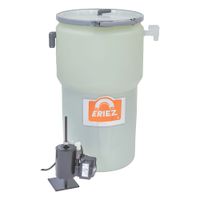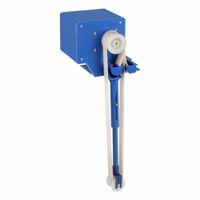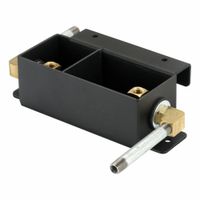Call +(254) 703 030 000 / 751 483 999 / 721 704 777
- Home
- Machining
- Coolant Systems Accessories
- Oil Skimmers Coalescers
.....Read More
Frequently Asked Questions
What is the difference between an oil skimmer and an oil coalescer?
An oil skimmer and an oil coalescer are both used for oil-water separation, but they operate on different principles and are suited for different applications.
An oil skimmer is a device designed to remove oil from the surface of water. It works by skimming the oil layer off the top, using various methods such as belts, disks, or tubes. Skimmers are effective for removing floating oil and are commonly used in applications like wastewater treatment, oil spill response, and industrial processes where oil accumulates on water surfaces. They are best suited for situations where oil is present in a relatively thick layer and can be easily separated from the water.
An oil coalescer, on the other hand, is designed to separate emulsified or dispersed oil droplets from water. It works by promoting the coalescence of small oil droplets into larger ones, which then rise to the surface due to their buoyancy. Coalescers typically use materials like mesh or media that provide a large surface area for droplets to collide and merge. They are used in applications where oil is mixed with water in fine droplets, such as in oil-water emulsions or in processes where oil is not easily separated by skimming. Coalescers are often found in oil refineries, petrochemical plants, and other industrial settings where fine oil-water separation is required.
In summary, the main difference lies in their application: oil skimmers are used for removing floating oil layers, while oil coalescers are used for separating emulsified or dispersed oil droplets from water.
How do oil skimmers work in removing tramp oils?
Oil skimmers are devices used to remove tramp oils from the surface of water or other liquids. They operate based on the principle of differences in specific gravity and surface tension between oil and water. Here's how they work:
1. **Collection Mechanism**: Oil skimmers use various collection mechanisms such as belts, disks, drums, or tubes. These components are made from materials that attract oil but repel water, allowing them to selectively collect oil from the liquid surface.
2. **Movement**: The skimmer's collection mechanism moves through the liquid, either by rotating or by being pulled through the liquid. As it moves, it picks up the oil that is floating on the surface.
3. **Separation**: Once the oil is collected, it is separated from the collection mechanism. This is typically achieved through a wiper blade or scraper that removes the oil from the belt, disk, or drum as it exits the liquid.
4. **Collection Reservoir**: The separated oil is then directed into a collection reservoir or tank. This allows for easy disposal or recycling of the oil.
5. **Continuous Operation**: Oil skimmers are designed to operate continuously, providing ongoing removal of tramp oils. This helps maintain the cleanliness of the liquid, improving the efficiency and lifespan of industrial processes and equipment.
6. **Types of Skimmers**: There are several types of oil skimmers, including belt skimmers, disk skimmers, drum skimmers, and tube skimmers. Each type is suited to different applications and oil types, offering flexibility in addressing various industrial needs.
By efficiently removing tramp oils, oil skimmers help prevent equipment fouling, reduce maintenance costs, and improve the quality of the process fluids.
What are the benefits of using oil coalescers in coolant systems?
Oil coalescers in coolant systems offer several benefits:
1. **Improved Coolant Quality**: By removing tramp oils, coalescers enhance the quality of the coolant, ensuring it remains effective in cooling and lubricating machinery.
2. **Extended Coolant Life**: Regular removal of oil contaminants prevents degradation of the coolant, extending its usable life and reducing the frequency of coolant replacement.
3. **Enhanced Machine Performance**: Clean coolant ensures optimal machine performance by maintaining proper lubrication and cooling, reducing wear and tear on components.
4. **Cost Savings**: By extending coolant life and reducing machine maintenance needs, coalescers help lower operational costs. They also minimize the need for frequent coolant disposal and replacement.
5. **Environmental Benefits**: Reducing the amount of waste coolant and oil that needs disposal helps in minimizing environmental impact, aligning with sustainability goals.
6. **Reduced Bacterial Growth**: Tramp oils can promote bacterial growth in coolant systems. Coalescers help in reducing this risk, maintaining a healthier work environment and reducing unpleasant odors.
7. **Improved Surface Finish**: Cleaner coolant contributes to better surface finishes on machined parts, enhancing product quality and reducing rework.
8. **Lower Maintenance Requirements**: By keeping the coolant clean, coalescers reduce the need for frequent maintenance of the coolant system and associated equipment.
9. **Increased Equipment Lifespan**: Consistent removal of oil contaminants helps in prolonging the lifespan of both the coolant system and the machinery it serves.
10. **Operational Efficiency**: With fewer interruptions for maintenance and coolant changes, overall operational efficiency is improved, leading to increased productivity.
How often should oil skimmer parts be replaced?
The frequency of replacing oil skimmer parts depends on several factors, including the type of skimmer, the operating environment, the quality of maintenance, and the manufacturer's recommendations. Generally, oil skimmer parts should be inspected regularly, and replacements should be made as needed to ensure optimal performance.
For belt skimmers, the belt is often the most frequently replaced part due to wear and tear from continuous operation. Depending on the material and the operating conditions, belts may need replacement every 6 to 12 months. Wiper blades, which remove oil from the belt, should also be checked regularly and replaced if they show signs of wear or damage.
In tube skimmers, the tube itself is subject to wear and may need replacement every 6 to 18 months, depending on the material and the environment. The drive system, including pulleys and bearings, should be inspected and maintained to prevent premature failure.
Disc and drum skimmers have fewer moving parts, but the discs or drums should be checked for wear and replaced if they become inefficient at collecting oil. This might be necessary every 1 to 2 years, depending on usage.
For all skimmer types, seals, gaskets, and other consumable parts should be inspected regularly and replaced as needed to prevent leaks and maintain efficiency. Regular maintenance, including cleaning and lubrication, can extend the life of skimmer parts and reduce the frequency of replacements.
Ultimately, following the manufacturer's maintenance schedule and guidelines is crucial. Regular inspections and proactive maintenance can help identify parts that need replacement before they fail, ensuring the skimmer operates efficiently and effectively.
Can oil skimmers and coalescers be used together?
Yes, oil skimmers and coalescers can be used together to enhance the efficiency of oil-water separation processes. Oil skimmers are devices designed to remove floating oil from the surface of water. They work by skimming the oil layer, which is then collected and removed for disposal or recycling. Skimmers are effective for dealing with oil spills or in industrial settings where oil contamination is present on water surfaces.
Coalescers, on the other hand, are used to separate emulsified oil from water. They work by promoting the agglomeration of small oil droplets into larger ones, which then rise to the surface due to their buoyancy. Coalescers are particularly useful in treating oil-in-water emulsions, where the oil is dispersed in small droplets throughout the water.
When used together, skimmers and coalescers can provide a comprehensive solution for oil-water separation. The coalescer can be used to treat the bulk of the oil-in-water emulsion, increasing the size of the oil droplets and making it easier for the skimmer to remove them from the surface. This combination can lead to more efficient removal of oil, reducing the oil content in the water to acceptable levels for discharge or further treatment.
In practice, the integration of both technologies can be tailored to specific needs, depending on the type and concentration of oil, the volume of water to be treated, and environmental regulations. By combining the strengths of both skimmers and coalescers, industries can achieve higher separation efficiency, lower operational costs, and improved compliance with environmental standards.
What types of oil skimmers are available for industrial use?
There are several types of oil skimmers used in industrial applications, each designed to remove oil from water surfaces efficiently:
1. **Belt Skimmers**: These use a continuous looped belt made of materials that attract oil. The belt passes through the contaminated water, picking up oil, which is then scraped off for collection.
2. **Disk Skimmers**: These feature a rotating disk that attracts oil. As the disk turns, oil adheres to its surface and is removed by a scraper. They are effective for thin oil layers.
3. **Drum Skimmers**: Similar to disk skimmers, these use a rotating drum to collect oil. The drum's surface attracts oil, which is then scraped off. They are suitable for various oil viscosities.
4. **Tube Skimmers**: These use a floating tube that attracts oil. The tube is pulled through the water, collecting oil, which is then squeezed off. They are versatile and can handle fluctuating water levels.
5. **Weir Skimmers**: These use a floating barrier to direct oil into a collection area. The oil is then pumped away. They are effective for large volumes of oil.
6. **Brush Skimmers**: These use rotating brushes to pick up oil. The oil adheres to the bristles and is then scraped off. They are effective for heavy oils and debris-laden environments.
7. **Suction Skimmers**: These use a vacuum system to suck oil from the water surface. They are versatile and can be used in various conditions.
8. **Floating Skimmers**: These are designed to float on the water surface and collect oil using various mechanisms, such as weirs or suction.
Each type of skimmer has its advantages and is chosen based on factors like oil type, water conditions, and the volume of oil to be removed.
How do I maintain and clean an oil skimmer or coalescer?
To maintain and clean an oil skimmer or coalescer, follow these steps:
1. **Regular Inspection**: Frequently inspect the skimmer or coalescer for any signs of wear, damage, or blockages. Check seals, belts, and other moving parts for wear and tear.
2. **Cleaning**:
- **Oil Skimmer**: Remove accumulated oil and debris from the skimmer. Use a scraper or brush to clean the belt, disk, or tube, depending on the type of skimmer. Ensure the wiper blades are clean and functioning properly.
- **Coalescer**: Drain the coalescer regularly to remove collected oil. Clean the coalescing media by flushing with water or a suitable cleaning solution to remove oil and particulates. Replace the media if it becomes clogged or damaged.
3. **Component Maintenance**:
- Lubricate moving parts as per the manufacturer's recommendations to ensure smooth operation.
- Tighten any loose bolts or screws and replace worn-out parts promptly.
4. **System Checks**:
- Verify that the skimmer or coalescer is properly aligned and positioned for optimal performance.
- Ensure that the flow rates and pressure settings are within the recommended range.
5. **Record Keeping**: Maintain a log of maintenance activities, including inspections, cleaning, and part replacements. This helps in tracking performance and scheduling future maintenance.
6. **Safety Precautions**: Always follow safety guidelines, such as wearing protective gear and ensuring the equipment is powered off during maintenance.
7. **Training**: Ensure that personnel involved in maintenance are adequately trained and familiar with the equipment's operation and maintenance procedures.
By adhering to these steps, you can ensure the efficient operation and longevity of your oil skimmer or coalescer.



